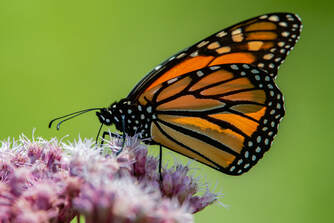 Photo by Richard Lee on Unsplash Photo by Richard Lee on Unsplash Running around the Central Park Reservoir in the warmer months, I often eye the milkweed plants along the north side of the path, wondering when the monarchs will arrive. These beautiful orange and black-patterned butterflies, seemingly delicate, make an epic annual migration over four generations in the course of a year. To my delight, this morning I noticed a number of monarchs, likely the year’s third generation. Averaging 50 miles a day for four to six weeks, monarch Generation 1 begins its migration in early September from as far north as Canada and travels as far as 2,100 miles to cool regions east of Mexico City. Arriving by the end of October, they hibernate until March, when they awaken, mate, and migrate to the Southern United States where they lay their eggs on milkweed and die. Generation 2 hatches, feeds, metamorphoses, and migrates north where it lays eggs, reaching the New York City area in late June. Generation 3 survives for 4-6 weeks, into late July/mid August, the monarchs we observe now around New York City. Their offspring, Generation 4, will arrive in Canada by August, where they will store energy to prepare for their September flight to Mexico. Milkweed offers monarchs important protection. Monarch larvae ingests the milkweed leaves and with them the plants toxins, which are poisonous to monarch predators, such as birds. On eating a monarch, birds learn of the toxin, vomiting up the butterfly and subsequently avoiding ingesting it. Other species of butterfly even mimic the monarch’s colors, nature’s way of helping them avoid predators who may confuse them with monarchs. Milkweed might look like an innocuous plant, standing without fanfare in a patch along the Central Park Reservoir. It takes on a different level of significance when one thinks about its role in the epic annual, multigenerational migration of monarch butterflies
0 Comments
Leave a Reply. |
About this Blog
Hi! I'm Nancy Kopans, founder of Urban Edge Forest Therapy. Join me on an adventure to discover creative ways to connect with nature in your daily life, ways that are inspired by urban surroundings that can reveal unexpected beauty, with the potential to ignite a sense of wonder. Archives
April 2023
Categories
All
|

 RSS Feed
RSS Feed